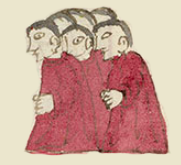teopan nenque (CST7)
This painting of the simplex glyph for the term teopan nenque (or teopan nenqueh, with the glottal stop), refers to church people, possibly people who dwell at the church. These are typically indigenous men. Diego Muñoz Camargo’s Historia de Tlaxcala, he refers to them variously as regidores, sacerdotes, or religiosos “de aquella religión” (of that, i.e., Nahua, religion). The glyph shows a group of what appear to be six men in floor-length red robes. The robes have black lines that add a three-dimensionality to the fabric. They are shown in profile, facing toward the viewer’s left. One hand from each of two men appears at waist height. See also the record for sacristan from this manuscript, which also calls the men teopan nenque, adding insight to the meaning of the Nahuatl term.
Stephanie Wood
These church people could be sacristans, given the similarity between this glyph and the glyph showing two sacristans from the Codex Sierra-Texupan (CST31), below. The singular of this term would be teopan nenqui. Attestations include the term both separated and joined (i.e., teopannenqui and teopannenque). The alphabetic explanation in the CST that refers to these men says that “they were given 32 pesos.” For more on the Codex Sierra, see Kevin Terraciano’s study (2021).
Stephanie Wood
1550–1564
Jeff Haskett-Wood
teopannenque, teopannenqui, teopannemi, iglesias, templos, ayudantes, religión

teopan nemi, a church person, https://nahuatl.wired-humanities.org/content/teopan-nemi
teopan, temple or church, https://nahuatl.wired-humanities.org/content/teopan
nenqui, a resident of some place, https://nahuatl.wired-humanities.org/content/nenqui
nemi, to live, https://nahuatl.wired-humanities.org/content/nemi
la gente de la iglesia
Stephanie Wood
Códice Sierra-Texupan, plate 7, page dated 1552. Origin: Santa Catalina Texupan, Mixteca Alta, State of Oaxaca. Kevin Terraciano has published an outstanding study of this manuscript (Codex Sierra, 2021), and in his book he refers to alphabetic and “pictorial” writing, not hieroglyphic writing. We are still counting some of the imagery from this source as hieroglyphic writing, but we are also including examples of “iconography” where the images verge on European style illustrations or scenes showing activities. We have this iconography category so that such images can be fruitfully compared with hieroglyphs. Hieroglyphic writing was evolving as a result of the influence of European illustrations, and even alphabetic writing impacted it.
https://bidilaf.buap.mx/objeto.xql?id=48281&busqueda=Texupan&action=sear...
The Biblioteca Digital Lafragua of the Biblioteca Histórica José María Lafragua in Puebla, Mexico, publishes this Códice Sierra-Texupan, 1550–1564 (62pp., 30.7 x 21.8 cm.), referring to it as being in the “Public Domain.” This image is published here under a Creative Commons license, asking that you cite the Biblioteca Digital Lafragua and this Visual Lexicon of Aztec Hieroglyphs.





